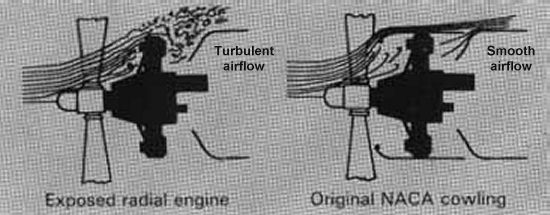|
||||||||||
|
|
||||||||||
|
||||||||||
|
|
||||||||||

A streamlined shape is one with a contour that is itself a streamline (such as the airfoil above), or its shape is such that its resistance to the flow of air, water, or another fluid past it is minimized. So when we talk about streamlining a body, we are trying to smooth out the external contours of the shape to create a streamlined flow over it and reduce the flow's resistance to that motion. This resistance is what we call drag, and this particular kind of drag is referred to as form drag.
The importance of drag was very much underappreciated in the early days of aviation, and this we can see in the many boxy, jagged, rough, and irregular aircraft of the early 1900s. In particular, the fixed landing gear, exposed engines, and wing bracing so common on early airplanes created significant drag that drastically reduced the performance of these aircraft. It was not until the 1920s that the true significance of drag began to be understood. The impetus for this research came when engineers with the National Advisory Committee on Aeronautics (NACA) discovered vast discrepancies in the drag data recorded in wind tunnel studies of propellers alone and propellers attached to fuselages. To resolve these discrepancies, NACA director George Lewis proposed the construction of a radical new wind tunnel four times larger than those typically in use at the time. Such a large wind tunnel would allow NACA to test full-sized aircraft fuselages and engines to accurately measure the drag data. Once completed in 1927, the Propeller Research Tunnel (PRT) rapidly revolutionized the streamlining of modern aircraft.
Almost immediately, researchers discovered that exposed landing gear contributed up to 40% of the drag on a fuselage, and manufacturers soon began incorporating retractable gear or streamlined gear fairings into their designs. Even more surprising was the discovery that nearly one-third of the fuselage drag was created by the exposed cylinders and other components of the air-cooled engines used at the time. Manufacturers had left the cylinders and cooling fins exposed to maximize cooling, but they had never had any idea how much of a drag penalty this caused.

NACA then set about designing a streamlined cowling that allowed sufficient air into the engine case for cooling but created a smooth external contour for the engine to reduce drag. In fact, the cowling that first appeared in 1928 was found not only to significantly reduce drag, but to significantly improve engine cooling because the airflow around the engine itself was much less turbulent.

The first production aircraft to benefit from this breakthrough research was the Lockheed Vega. The original
design managed to fly nonstop from Los Angeles to New York at an average speed of 157 mph (253 km/h). Following a
redesign in which a NACA cowling was added and the exposed landing gear tires and struts were covered with
streamlined fairings, the same trip was made at an average speed of 177 mph (285 km/h), a 13% increase.
- answer by Jeff Scott, 3 March 2002
Related Topics:
Read More Articles:


|
Aircraft | Design | Ask Us | Shop | Search |

|
|
| About Us | Contact Us | Copyright © 1997-2023 | |||
|
|
|||